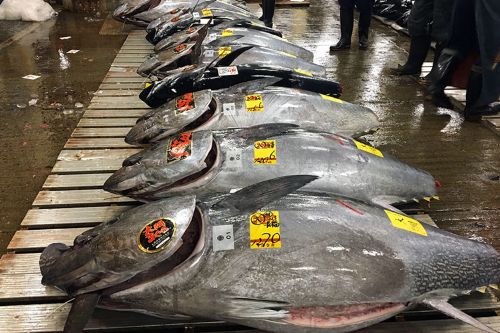
Large fish that are caught are always kept and transported on their side with their heads facing left from the port to the market and to the restaurant where they are served. The part of the fish facing down when in this position is called “Shitami (下身)” or the “bottom body” and the part facing up is called “Uwami (上身)” or the top body. The Uwami costs more than Shitami. This is because the Shitami takes on the weight of the Uwami, reducing the freshness and possibly causing cracks in the body (cracking occurs on the edges of the muscles).
This mostly applies to Pacific bluefin tuna (tuna that is consumed without any freezing after being caught). To be precise, the post-harvest handling is fundamentally the same not only for bluefin tuna but also for other large fish like buri (yellowtail) and kanpachi (greater amberjack). However, it starts after the fish arrive at the fishing port and are sorted. At any rate, since this fish costs hundreds of dollars per kilogram, a full-grown fish may be worth more than a luxury sports car. Therefore, from the time they make their catch, the fishermen work quickly, which affects all aspects of the quality. Most of all, this work affects the price. A Pacific bluefin is never placed directly on the deck of the ship. If a fish weighing 100 kg or more is set directly on the hard deck, its own weight would cause injury to its surface. Naturally, any damage or injury to the fish reduces the price. Instead, each fish is laid on a soft, spongy mat to protect its skin surface. Next, the blood is drained, the spinal cord nerves are destroyed and the fish is submerged in ice water. It might be easier to understand if you imagine handling a luxury vehicle, like a Ferrari, rather than a tuna fish.
Incidentally, the idea behind keeping the “Left side up (or prioritized), right side down,” is a fixed Japanese etiquette, passed down through China from the Asuka period. Perhaps the reason fish are also served for eating and photographed with the head on the left side is due to this influence as well. However, this is only a fixed practice within Japan.
At sushi restaurants, one of the many things the chef teaches their apprentice is to, “Start using purchase fish from ‘Shitami’.” Once a sushi topping is prepared, it may be served for several. It’s hard to imagine that the Shitami would start to go bad during these several days, but it is attention to these small details that make a master sushi chef.
Related contents: TYPES OF TUNA
[sc_apply url=”https://sushiuniversity.jp/apply/”]
We hope this information will be helpful.

Revision date: December 25, 2025
Share this article